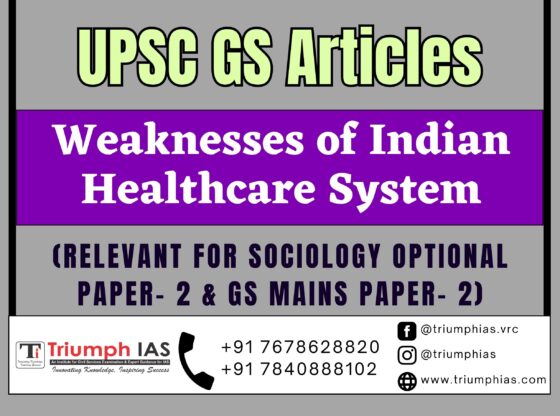Weaknesses of Indian Healthcare System
Relevant for sociology optional Paper- 2 & GS Mains Paper- 2

India’s healthcare system faces several weaknesses that continue to pose significant challenges to the health and well-being of its citizens. Despite the efforts of the government and other stakeholders, the healthcare system remains plagued by several issues that limit its effectiveness in meeting the needs of the population.
One of the major weaknesses of the Indian healthcare system is inadequate infrastructure. The country’s healthcare infrastructure, particularly in rural areas, is inadequate to meet the growing healthcare needs of the population. Many healthcare facilities lack basic amenities such as electricity, water supply, and sanitation, making it difficult for healthcare providers to deliver quality healthcare services. This shortage of infrastructure is particularly acute in the public healthcare system, which serves the majority of the population.
Another significant weakness of the Indian healthcare system is limited access to healthcare services. Despite the government’s efforts to improve access to healthcare services, many people in India still face significant barriers to accessing healthcare. These barriers include a shortage of healthcare providers, particularly in rural areas, long waiting times, and high out-of-pocket costs, which can be prohibitively expensive for many families. This limited access to healthcare services contributes to poor health outcomes and exacerbates health disparities across the population.
Health disparities are another significant weakness of the Indian healthcare system. There are significant disparities in healthcare outcomes and access to healthcare services across different segments of the population, with marginalized communities and lower-income households bearing the brunt of these disparities. For example, infant mortality rates are higher among marginalized communities, and the incidence of communicable diseases such as tuberculosis is higher in lower-income households. These disparities are often driven by social determinants of health, such as poverty, lack of education, and inadequate access to clean water and sanitation.
The Indian healthcare system also faces challenges in the area of human resources. Despite the high burden of disease in India, the country has a shortage of healthcare professionals, particularly in rural areas. This shortage of healthcare professionals contributes to the limited access to healthcare services in these areas and undermines the quality of healthcare services that are available. Additionally, the healthcare workforce is often overburdened and underpaid, leading to low levels of job satisfaction and high rates of attrition.
Another significant weakness of the Indian healthcare system is the lack of adequate health insurance coverage. The majority of the population in India does not have access to health insurance, which can lead to significant financial hardship in the event of a serious illness or injury. Even those who do have health insurance often face significant out-of-pocket costs, which can be prohibitive for many families. This lack of adequate health insurance coverage contributes to the financial burden of healthcare on families and limits their ability to access the care they need.
The Indian healthcare system also faces challenges in the area of healthcare financing. The government’s expenditure on healthcare remains low, accounting for just over 1% of the country’s GDP. This low level of investment in healthcare limits the government’s ability to improve healthcare infrastructure, attract and retain healthcare professionals, and provide adequate healthcare services to the population. Additionally, healthcare financing is often fragmented, with multiple sources of funding and a lack of coordination between different stakeholders, leading to inefficiencies in the healthcare system.
In conclusion, the Indian healthcare system faces several weaknesses that continue to pose significant challenges to the health and well-being of the population. Inadequate infrastructure, limited access to healthcare services, health disparities, a shortage of healthcare professionals, lack of adequate health insurance coverage, and healthcare financing challenges all contribute to the limitations of the healthcare system. Addressing these weaknesses will require a multi-sectorial approach that involves increased investment in healthcare infrastructure, improvements in healthcare financing, and greater efforts to address health disparities and improve access to healthcare services for all citizens. By addressing these weaknesses, India can make significant progress towards achieving its healthcare goals and ensuring that all citizens have access to quality healthcare services.
For more such free UPSC notes, Articles, News & Views Join our Telegram Channel. https://t.me/triumphias
Click the link below to see the details about the UPSC – Civils courses offered by Triumph IAS. https://triumphias.com/pages-all-courses.php


